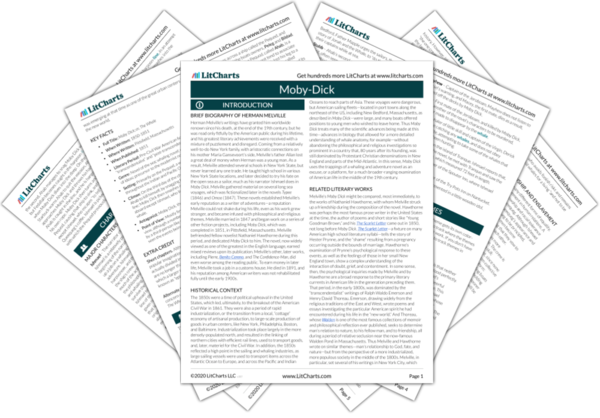Summary
Analysis
Ishmael attempts to lay out for the reader a systematic overview of the kinds of whales, and the divisions into which whales might be separated. Ishmael notes that, though a great many writers from Biblical times onward have mentioned whales or leviathans in their texts, very few have a scientific understanding of whales, and even fewer know much about the sperm whale, the “king of the seas” and the whale being hunted by the Pequod. On the topic of whether a whale is a fish, Ishmael cites a good deal of scholarship debating the issue, but concludes that whales ought to be defined as “spouting, horizontal-tailed fishes with lungs and warm blood.”
A famous chapter in the novel, one often referenced when critics speak of its “contemporary” or “postmodern” nature. Here, Ishmael attempts to help himself and the reader to understand whales through scientific means of observation and classification. And yet while this effort is elucidating it also highlights, purposely, that scientific knowledge can't explain all, or provide all understanding. Whales remain mysteries despite what is scientifically known about them, and thus they serve as a metaphor for nature and the world, for the spirit that men sense but can't define.
Themes
Quiz
Test Yourself
Ishmael divides the whales as though they are books. Book 1, chapter 1 is the sperm whale, the “spermaceti,” the most majestic and most valuable (for its oil). Book 1, Chapter 2 is the right whale, which is also hunted like the sperm whale, but which produces an “inferior oil.” Book 1, Chapter 3 is the fin-back whale, a “solitary” whale apparently marked, like Cain in the Bible, and separated from its fellow whales, swimming mostly alone. Ishmael also identifies the humpback, the razor-back, and the sulphur-bottom whales, although he states that he knows little about them, other than the basic features of their appearance, and their lack of oil-value.
The right whale serves as an interesting foil to the sperm whale, which, like Ahab, Ishmael considers to be the most noble on the seas, something akin to whale royalty. The right whale, on the other hand, is less noble, because it does not hunt for its food, but rather skims the water for small organisms. The right whale is also not as “majestic” when it swims, and its head and body cannot be used for the harvesting of the most useful of whale products—sperm oil.
Themes
Literary Devices
Quiz
Test Yourself
Book 2 consists of the smaller whales—the grampus, the black-fish, and the narwhal. Many scholars debate whether or not these specimens are actual whales, and Ishmael states that the narwhal is notable for its tusk, whose purpose is debated among scientists. Ishmael wonders if the narwhal isn’t singled out for its resemblance to the unicorn, which seems to inspire in men a kind of romantic sentiment. Ishmael rounds out Book 2 by discussing the killer whale briefly, stating that these whales tend not be hunted by Nantucketers.
Other whales might have a kind of scientific value—or, in the case of narwhals, a literary one—but they, too, lack the excitement of the sperm whale, perhaps because they do not produce oil, and perhaps because they do not put up nearly as much of a fight when caught. Indeed, the reader might wonder whether sperm whales aren’t valued because of the difficulty men have in hunting them.
Themes
Quiz
Test Yourself
The final book, Book 3, consists of what Ishmael calls porpoises. Ishmael notably has a harder time differentiating among the porpoises, and among other kinds of “pseudo-whales.” Ishmael then closes this chapter by saying that cetology, as a science (the study of whales) has much to be added to it, and that that branch of science, much like this narrative Ishmael is writing, is “but a draft—nay, but the draft of a draft.”
A very important moment in the novel. That the novel itself might be a “draft”—an attempt to describe a subject that is too vast, too complex for one book—is another “postmodern” or contemporary-seeming idea. Melville clearly viewed his novelistic enterprise as Ishmael does, here—one that is impossible to fully complete. It also captures the idea of scientific and all knowledge, that it is some thing that is always growing, always revising and rewriting itself.
Themes
Quiz
Test Yourself
Get the entire Moby-Dick LitChart as a printable PDF.













